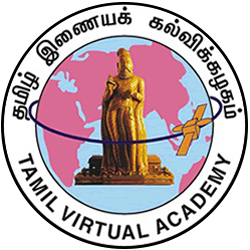Primary tabs
-
d03145 Lesson 5 Porulani Iyal-V
This lesson talks about anigal 22 to 27 mentioned in the "Dandialangaaram". They are "Uthaatha Ani", "Avanuthi Ani", "Siledai Ani", "Viseda Ani", "Oppumai Koota Ani" and "Virodha Ani". The lesson offers a definition of these 6 figures of speech and discusses their types. It also provides examples from literary texts in order to explain them.
Some anigal or figures of speech are based on the subject or theme underlying the verse. "Uthaatha Ani"is one such ani. This ani is also called "Veerukol Ani". This ani is used to express the greatness of a noble heart or the abundance of wealth. The 2 types of Uthaatha Ani are "Selva Miguthi" and "Ulla Miguthi". While the Selva Miguthi is used to describe boundless wealth, the Ulla Miguthi is used to extol the virtues of a noble heart.
When a poet discounts or refutes the inherent attributes of an object and bestows a different attribute on the object, it is called "Avanuthi Ani". The 3 types of Avanuthi Ani are, "Sirappu Avanuthi", "Porul Avanuthi" and "Guna Avanuthi".
The technique of using homonyms, homophones and phrases that have different contextual meaning for rhetorical effect in poetry is called "Siledai Ani". Poets use this figure of speech when they want to convey more than one meaning through their verse. The Siledai Ani is also called "Irattura Mozhithal". The Siledai Ani is of two types: "Semmozhi Siledai" and "Pirimozhi Siledai".
Poets sometimes have to sing of the inadequacies and failings of their subject. In such cases, a skilful poet projects the shortcomings of his subjects as becoming of him or her. This poetic technique of rendering one's negative attributes in a positive light is called "Viseda Ani". The 5 types of Viseda Ani are "Gunakurai Visedam", "Thozhilkurai Visedam", "Saadhikurai Visedam", "Porulkurai Visedam" and "Urupukurai Visedam".
While describing an object, poets sometimes use the technique of juxtaposing the object with other objects that are equal in terms of attributes and qualities. This is called "Oppumaikoota Ani". When this figure of speech is used to praise an object it is called "Pugazh Oppumaikootam". When it is used to denounce an object it is called "Pazhippu Oppumaikootam".
The figure of speech that juxtaposes antonyms and phrases contradictory in meaning to create a paradox is called "Virodha Ani". The two types of Virodha Ani are "Sol Virodham" and "Porul Vorodham". Virodha Ani is also known as "Muran Thodai".


